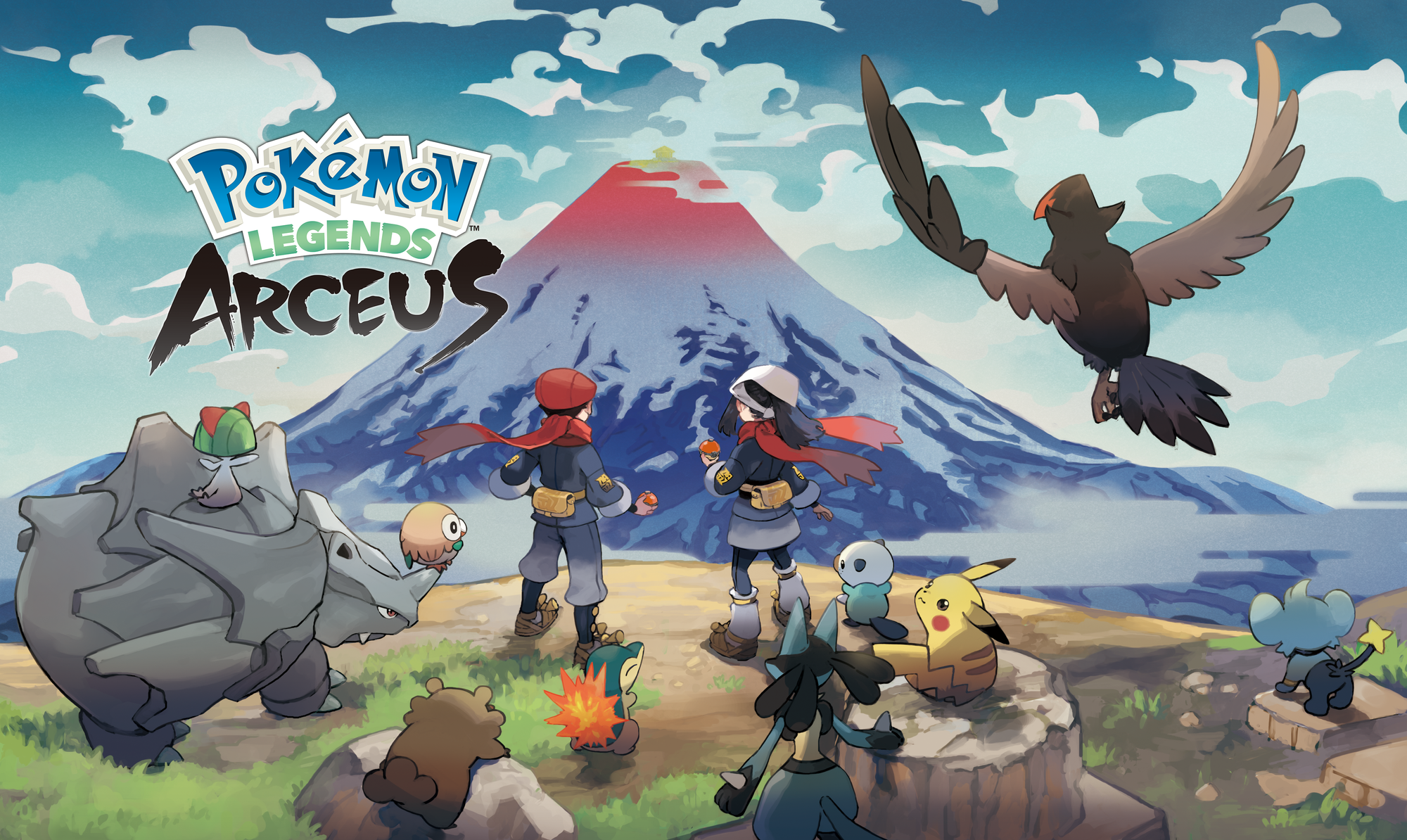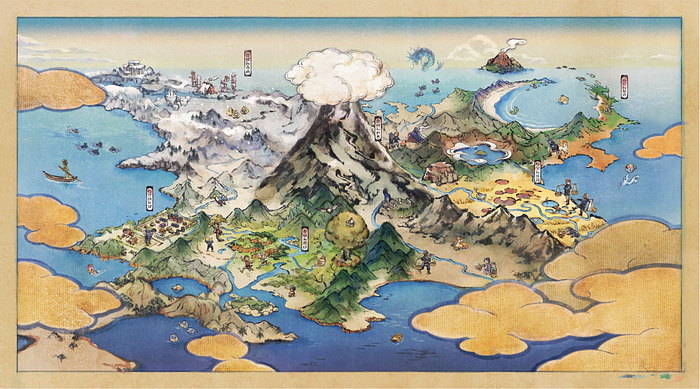Pokémon Legends: Arceus Fixes the Problems With the Franchise
An open-world concept, intriguing story, improved battle system, and I can finally get all the Eeveelutions to hang out with me in a room? Sign me up.

I will be the first to admit I don’t have much experience when it comes to Pokémon. I was a fan of the anime when I was a kid, and I’ve played my way through Diamond, but I’m not a die-hard fan. The biggest reason was that all of the games felt very much the same to me; what did it matter which edition I had when it was always grab a starter, turn on EXP share, and grind your way through the Elite Four?
The announcement of Pokémon Legends: Arceus threw me for a loop. It was an open-world concept, which I love in games, that had a completely different storyline from the other installments in the franchise. No Elite Four? No gyms? What was this madness? I knew I had to try it.
The second I started the game, I didn’t want to put it down. I’ve barely put it down even now, a month later, and I doubt I’ll get tired of it for quite some time. Pokémon Legends: Arceus took many of the big problems I have with traditional Pokémon games and solved them expertly.
A Brand New Pokemon Story
So the usual story with Pokémon is pretty formulaic. You’re a 10-year-old who’s just starting out on their adventure to become a Pokémon trainer. But oh no! Some big evil team named the Something Team is here to take over the world using Pokémon for some elaborate plot that usually involves a lot of stealing and grunts with Geodudes.
Your job is to go around with your faithful party, defeat gym leaders to earn badges that grant you entry to the Elite Four, and defeat the Something Team along the way to save the world. Beating the Elite Four means that you, a 10-year-old, are the newest Pokémon Master.
Let’s be honest. Does anyone play these games for the story anymore? Or are you playing it because your starter is adorable and you like the battle music? It’s not a bad story and they’re not bad games by any means, but you can always tell exactly what’s going to happen and when. After so many games, it can get a little boring.
PLA goes in a completely different direction. You’re playing as a 15-year-old this time, with some canonical experience catching and raising Pokémon. You’re suddenly shunted back in time by a mysterious voice that asks you to 1) collect all the Pokémon and 2) reunite this world. Only after that will you meet them again.
You wake up on a beach with Professor Laventon chasing down three Pokémon. Apparently, in this particular time period, Pokémon are still regarded as dangerous, feral creatures that humans can barely interact with safely. You join the Survey Corps of Jubilife Village to try and establish the first-ever Pokédex, with some help (and hindrance) from the other locals of Hisui, the Diamond and Pearl clans (I see what you did there, Nintendo).
There are no gyms; instead, you’re working to calm down frenzied “noble” Pokémon, who are said to be descendants of the god of this particular region. Along the way, you’re learning more and more about this god, Sinnoh, and the people who worship it in different ways.
This story is fascinating to me. I love the depth of the story to show off the different values and beliefs of the three groups, the history they have with one another, and the dynamics between them all. You explore not only the geography and biology of the region but also its culture and political atmosphere. It’s an extremely character-driven story, which is totally different from the previous formula, and I can’t get enough of it.

Hisui and the Open World
One of my favorite things about PLA is its map. In a traditional Pokémon game, the maps are…lackluster. You travel along set routes between little towns and the occasional city or safari park until you hit the end of the road and…that’s it. The routes are, at best, boring and, at worst, incredibly annoying to traverse with random encounters and inescapable trainer battles between you and a much-needed Pokémon center. I have a lot of trouble distinguishing the maps from the different games; they all run together for me.
PLA’s map is nothing like that. In this game, you have a singular hub, Jubilife Village, to which you return in order to get new missions, trade out Pokemon, shop, and even customize your character. From this town, you can go to any one of the five regions of the game, once you’ve unlocked them.
These regions are themselves open maps with various terrain and challenge levels. Obsidian Fields, your introductory area, is filled with Pokémon ranging from levels 2 and 3 up to about 17 (not counting Alphas). In comparison, the late-game Alabaster Icelands is filled with level 50+ Pokémon, which can make your life a little difficult if you bring a low-level team. Each new part of the map feels like a new level in the game…which, I suppose, they are.
Each area also feels like a complete habitat; it has its own weather patterns from breezy sun to thunderstorms, hills and valleys, lakes and rivers that flow logically together, and a series of well-thought-out base camps to stop and take rests in whenever you need to restore your Pokemon or stock up on supplies. Some areas have ruins you can wander through or little habitats made by the Pokémon themselves (I really love the Bidoof dam in Obsidian Fields). There are so many little things to find and explore on the map — you could spend hours going through every little nook and cranny of it.
But the real winner of this particular level setup is that each area has natural placements for its Pokémon. You can see them wandering around, eating, sleeping, and just existing in the world. This feels like an addition from Pokémon Snap, which was all about letting these lovely animals do their thing without getting in the way. I appreciate that the animals will leave you alone if you don’t get too close; some even run, as they’re not looking for a fight. This adds a layer of realism to the game, which I think is awesome.
You can also take your Pokémon out of their Pokéballs to just…hang out with you. You can talk to them and sometimes, they even fall asleep! Silly as it is to say, I love this a tremendous amount and definitely spend a lot of my time just hanging out with my cute little buddies.
Getting to a high point on any of the maps means seeing a beautiful vista laid out, which to me, hits in a similar way to the opening of The Legend of Zelda: Breath of the Wild. Instead of feeling like you’re in a video game map that was designed to bring you from Point A to Point B as smoothly as possible, you get the sense that you are in a world that could and did exist well enough without you.
Oh, and the best part? There are no random trainers or 12,000 Zubats in caves waiting to ambush you!

Better Battling and Evolving
There are also significant changes made to the battling system in PLA, which is interesting. In previous games, the well-established battle method was that you could order your team in a certain way, and then you fought in that order unless you actively chose to change Pokémon as your action. You also wouldn’t know exactly when it was going to be your turn, as you couldn’t see the speed stat for the opposing Pokémon or any indicators, which made it difficult to pull back before someone faints.
In PLA, you can choose who starts your battle by having them selected in your rotating menu when you either throw a Pokéball or enter a cutscene to start the fight. This means that you can adjust for type before you get in the arena. Additionally, if your Pokémon goes down, you can select who goes next rather than defaulting to whoever was next in line, which is great when you need to speed a battle along or want a specific move set. You can also see whose turn it is in a sidebar on the right-hand side of the screen, which you can toggle on and off to still see the action.
A feature I find interesting, if a bit annoying, is that you as a trainer can now be hit with Pokémon moves. If you’re spotted in the wild by an aggressive Pokémon or standing in the wrong place in battle, you can definitely get knocked out by jets of water, spurts of flame, or just straight-up rocks getting thrown at your head.
It’s both hilarious (never stand in front of a Rapidash doing Flame Wheel) and incredibly annoying when you’re trying to get a good angle on the fight and accidentally clock yourself in the middle of it. Still, I like the realism it brings. I also wouldn’t want to stand too close to these guys while they’re doing their thing.
One major battle-adjacent change is that EXP is automatically shared between Pokémon. Now, I’m aware that not everyone liked this; making the feature mandatory as opposed to optional is going to throw off lots of play styles. Personally, though, I love that I can level my Pokémon together at the same rate from the get-go. It also makes leveling up weaker Pokémon a thousand times easier when you’re late in the game.
Related to this, evolving your Pokémon is no longer automatic. This makes it significantly easier to obtain tricky evolutions that require specific conditions; this is the first game in which I’ve gotten every Eeveelution on the first try rather than a thousand Sylveons (I can’t be mad at Sylveon, though). It’s also nice to be able to finish the research tasks for a lower evolution before evolving them so that you don’t have to catch a new one. On top of that, the evolution animation is significantly cooler now!
Pokemon Legends: Arceus is Just Fun
Pokémon Legends: Arceus is not a perfect game. Lots of the requests from NPCs are basic fetch-quests that send you all over the map for minimal rewards. The physics during some of the noble fights are frustrating and can make completing the battle very difficult if you move in just the wrong way. Having to go back to Jubilife Village to go to any other part of the map is very frustrating in the late game, when you need to go pretty much everywhere to finish the storyline. There are little things that make the experience of playing somewhat annoying.
But overall, I can’t say I have a major issue with it. Pokémon Legends: Arceus fixes the major problem of overly formulaic storytelling by presenting us with a brand-new way to experience the Pokémon world. I have loved every second of playing this game, and have been surprised at multiple turns by what it has to offer. It’s safe to say that I will happily buy future games in this style.
You may not be able to beat the classics, but taking that nostalgia and applying it to modern game mechanics and design was a brilliant move on the part of the Pokémon team.
